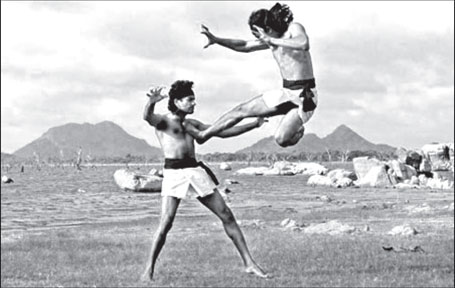Angam fighting - a heritage to be preserved
By Amal Hewavissenti
Angam fighting or Angam Pora involves all the philosophies and
techniques of self defence which have evolved for centuries on the
rhythm of human body, nature and movements of animals. This martial art
has been secretly preserved to the present generation by particular
schools of martial art which trained selected persons in certain
institutions solely meant for the purpose in the past.
 Angam fighting and its development full frontally reflect deep study
of animal like and their modes of attack and self defence - how most
powerful animals think, how they identify nature, how they sense danger
and how they react to the unexpected. Angam fighting and its development full frontally reflect deep study
of animal like and their modes of attack and self defence - how most
powerful animals think, how they identify nature, how they sense danger
and how they react to the unexpected.
The Angam fighter must be capable of reading the opponent's mind
accurately, identifying and responding to his movements and employing
power to neutralise his resistance, if necessary.
Techniques
It is definitely an art beyond a combination of techniques of self
defence and attack. It is a grand show where fighters dynamically fly
into air, make fast, energetic movements and returns to the ground with
a surprising speed and agility. They fight, give rise to a cloud of
dust, rise to the air, attack, position themselves and imitate animal
techniques of self defence with the spectacular rhythm of human body.
It is generally inferred that particular elements of martial art
which ancient Sri Lankan tribals upheld for their safety subsequently
became a systematic art. It is also accepted that certain components
were added to the art at varied phases of evolution before it came to be
what it really is today.
Thus, the Angam fighting came to be a scientifically developed
martial art when it was nourished at different stages by a store of
knowledge and experiential paths of fighting. Later the fighting was
upheld and developed by royalty and other important people.
There was an unwritten law that demanded that any person wishing to
attain kingship in Sri Lanka should have been well versed in Angam
fighting. Thus, Angam fighting emerged as a vitally important art under
intense situations of violence and battles in ancient Sri Lanka and it
grew by leaps and bounds under state patronage.
The study of energy pathways (meridians) and sensitive points in the
body is the most important and most secret aspect of this art of
fighting. Exclusive families expert in Angam fighting take special care
not to impart this knowledge or teach Angam techniques to a person who
may not be a trust worthy student or may be outside their family
lineage. Angam fighting has become prominently important chiefly because
of the techniques based on sensitive points and meridians in human body.
A person who has mastered this art is capable of crippling the
opponent's strength completely by a single blow or even a hard squeeze
on a point.
Knowledge
It is important to note that the most accomplished Angam fighter does
not endeavour to use his ultimate knowledge of the vital points of the
body to kill or paralyse his opponent. However, the Angam fighter
focusses on the speed of his attack, astrological aspects on the day,
and the direction of the attack on the opponent in order to bring his
fighting to the perfection.
The deep study of points and meridians in the body associated with
Angam fighting can be effectively utilised to cure illnesses. Angam
fighting concentrates on points of the body both for damaging and curing
a person. Knowledge of this aspect may enable a fighter to press a
certain point in the body and cure eye disorders, trembling, paralysis,
nerve disorders and chronic headache in short Angam fighting promotes a
person's inner strength of both body and mind.
During the fight, the fighters can fight with bare hands and feet
alone or fight using shields, swords or other forms of weapons.
Records about the art
The scenes of complex Angam fighting illustrated on famous Embekke
wood carvings prove that this form of martial art has been popular both
as a method of fighting and a therapeutic art. An ancient fabric paining
found in Hanguranketha Devale illustrates two factions fighting each
other with swords and shields.
In the 'Kegalla Report' written by H.C.P. Bell, numerous accounts and
legends associated with Angam fighting have been included. Bell narrates
how a fatherless girl masters Angam fighting in a foreign country
(Burma) and returns to Sri Lanka to take revenge on the killer of her
father.
According to Bell, there were two major opposing teams of Angam
fighting namely "Sudhaliye" and "Maruwalliye" that frequently battled in
open spaces in their bid to display the superiority and the capacity of
each.
A girl (later Edanduwawe Disapathini) who was afflicted with her
father's being killed by a "Sudhaliye" fighter went to Burma and learnt
all techniques of Angam fighting. Later back in Sri Lanka she engaged in
a life and death fight with the killer of her father and delivered a
lethal blow to the opponent.
According to the diary records of John d' Oyly, woven mats, dummies
and wooden swords were used in the basic training in Angam fighting
during Kandyan period. During this period, provincial chiefs such as
Palipana and Molligoda became the respective leaders and masters of
Maruwalliye and Suddhaliye factions.
As John d' Oyly claims, the army well trained in Angam fighting was
called "Panikki". Angam fighting started with a grand ceremony at an
astrologically planned time.
Angam fighting with its own identity as a multi-faceted martial art
is still practised in particular regions in Sri Lanka but in total
obscurity and secrecy. In whatever way, it is a national heritage to be
preserved for the future generation. |


